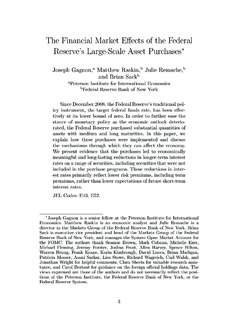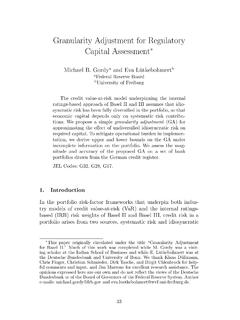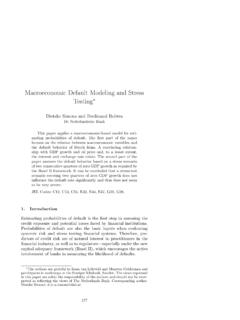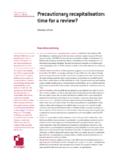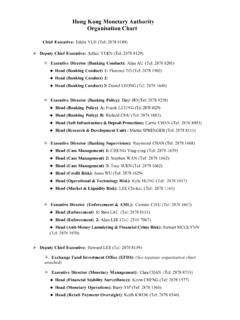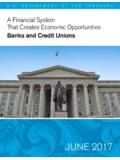Transcription of Financial Stability and Monetary Policy: How …
1 Financial Stability and Monetary Policy: How Closely Interlinked? frank SmetsEuropean Central BankThe recent Financial crisis has again raised the questionto what extent price- Stability -oriented Monetary policy frame-works should take into account Financial Stability this paper I argue that the answer will depend on threequestions: (i) how effective is macroprudential policy in main-taining Financial Stability ? (ii) what is the effect of monetarypolicy on risk taking and Financial Stability ? and (iii) what isthe risk of Financial dominance, , the risk that Financial sta-bility considerations undermine the credibility of the centralbank s price Stability mandate? I review the theory and evi-dence and conclude that while the new macroprudential policyframework should be the main tool for maintaining financialstability, Monetary policy authorities should also keep an eyeon Financial Stability .
2 This will allow the central bank to leanagainst the wind if necessary, while maintaining its primaryfocus on price Stability over the medium Codes: E58, IntroductionThe 2007 8 Financial crisis and its long-lasting legacy have shakenup the macroeconomic policy framework that appeared to be sosuccessful in stabilizing the economy during the Great Moderationperiod. First, it led to a rethinking of Monetary policy frameworksfocused primarily on maintaining price Stability , as price Stability Copyrightc 2014 European Central Bank. This note is a shortened versionof Smets (2013). The views expressed are my own and not necessarily those ofthe European Central Bank. I would like to thank Helge Berger, Stefan Gerlach,Otmar Issing, Manfred Kremer, Andy Levin, Nellie Liang, Tobias Linzert, AngelaMaddaloni, Lars Svensson, and Sweder van Wijnbergen for discussions Journal of Central BankingJune 2014has proven not to be a sufficient condition for Financial Stability andlack of Financial Stability can have large negative feedback effectson price , it accelerated the introduction of a newpolicy domain called macroprudential policy , inspired by the earlycontributions of Crockett (2000) and his colleagues at the Bank forInternational Settlements (BIS).
3 2 This was based on the realizationthat ensuring the soundness and safety of individual Financial insti-tutions is not enough to guarantee the Stability of the whole financialsystem and that there is a need for a systemic approach to with the description in International Monetary Fund(IMF) (2013), the newly emerging paradigm is one in which bothmonetary policy and macroprudential policies are used for coun-tercyclical management: Monetary policy primarily aimed at pricestability; and macroprudential policies primarily aimed at financialstability, whereas microprudential policy focuses on the safety andsoundness of individual Financial institutions. Macroprudential poli-cies aim to prevent, or at least to contain, the buildup of financialimbalances and to ensure that the Financial system is able to with-stand their unwinding and be resilient to ,4 The assignmentof the Monetary and macroprudential policy domains to separateobjectives is consistent with Tinbergen s effective assignment prin-ciple, which says that (i) one should have as many instruments1 Early contributions to this debate include Bean et al.
4 (2010), Blanchard,Dell Ariccia, and Mauro (2010), and Mishkin (2010). See also Baldwin andReichlin (2013) for a variety of views and Eichengreen, Prasad, and Rajan (2011).2 See, for example, Borio (2003) and Borio and White (2003). For a recentreview of the literature on macroprudential policy , see Galati and Moessner(2011).3 See Papademos (2009). The relative importance of the twin objectives ofcounteracting the procyclicality of the Financial system ( , smoothing the finan-cial cycle) and improving the resilience or fragility of the Financial system inresponse to shocks is still a matter of debate. The answer depends in part onhow effective macroprudential policies are expected to be in leaning against thewind, which is discussed in section below.
5 In this paper, we mostly focus onthe first related discussions of the objectives of macroprudential policy andthe concept of systemic risk, see, for example, Brunnermeier et al. (2009), DeBandt, Hartmann, and Peydr o (2009), European Central Bank (2010), EuropeanSystemic Risk Board (2011), and Hanson, Kashyap, and Stein (2011).Vol. 10 No. 2 Financial Stability and Monetary Policy265as objectives and (ii) the instruments should be assigned to thoseobjectives that they can most efficiently general, the introduction of macroprudential policies canimprove the trade-offs for Monetary policy and increase its roomfor maneuver. Maintaining Financial Stability can help ensure a well-working Financial system and an effective transmission process whichmakes achieving price Stability more efficient.
6 Moreover, macropru-dential policies can, by managing the Financial cycle and increas-ing the resilience of the Financial sector, reduce the probability ofsystemic stress and therefore the probability that Monetary policybecomes constrained by the zero lower bound and needs to resort tonon-standard policies to address malfunctioning Financial can also reduce trade-offs that may arise when exiting accom-modative Monetary relationship between Monetary and macroprudential poli-cies also hinges, however, on the side effects that one policy hason the objectives of the other and how perfectly each operates inthe pursuit of its own primary example, changes in policyinterest rates or non-standard Monetary policies may affect risk-taking behavior ex ante and the tightness of credit constraints expost as analyzed in the paper by de Groot published in this a crisis situation, liquidity policies by the central bank may avoida collapse of the banking sector, but also reduce the incentive forbanks to recapitalize and restructure and promote the evergreen-ing of non-performing loans and regulatory forbearance by supervi-sors.
7 In principle, well-targeted macroprudential policies can offsetthe side effects of these Monetary policies, but in practice theremay be , changes in macroprudential policy mayaffect financing conditions, the real economy, and price Stability ,5Or, as in Bean et al. (2010): Policies should be assigned to the frictions thatthey have a comparative advantage in addressing. 6 See, for example, Bernanke (2013) for a discussion in the current context ofexit from expansionary Federal Reserve Gerlach et al. (2009), Carboni, Darracq Pari`es, and Kok (2013), and IMF(2013).8 For example, as discussed in section , Maddaloni and Peydr o (2011) showthat the effects of Monetary policy on bank lending standards depend on thetightness of the prudential Journal of Central BankingJune 2014which Monetary policy may want to is therefore impor-tant that both policies are coordinated and take those interactionsinto account.
8 Conflicts of interest of a push-me, pull-you naturemay arise when Monetary and macroprudential policy instrumentsare used more aggressively, in opposite directions, leading to a worseoutcome than if the instruments had been ,non-standard Monetary policy instruments, like changes in haircutsfor central bank operations or changes in reserve requirements, arenot that different from macroprudential policy instruments such asliquidity constraints and regulation of margin requirements. It istherefore a legitimate question which instrument should be used forwhat need for coordination raises the question of the appropriateinstitutional setup. Overall, as a result of the crisis, central bankshave been given a larger role in maintaining Financial Monetary and macroprudential policies under one centralbank roof will tend to solve possible coordination problems that mayarise from their interaction.
9 At the same time, it may lead to incen-tive problems if failure of one policy domain affects the other policydomain. One example of such an incentive problem which may leadto time inconsistency is that Monetary policy is kept looser thanis necessary for price Stability because it helps maintain financialstability. This may lead to an inflation bias in particular, if theobjectives of the macroprudential policy function are not clearlyspecified, its effectiveness is not ensured, and/or macroprudentialpolicy measures are subject to more intense political scrutiny andpressure. One solution is to maintain a clear separation of objectives,instruments, and communication of the two policy domains.
10 Thiswill make the policymakers accountable for achieving their respec-tive objectives and thereby increase the effectiveness and efficiency of9 For an example of such an optimal Monetary policy reaction, see Collard etal. (2013).10 Examples of such outcomes are shown in Bean et al. (2010), Angelini, Neri,and Panetta (2011), and De Paoli and Paustian (2013).11 Cecchetti and Kohler (2012) provide an extreme example: In their model, itdoes not matter which authority uses which , for example, the new institutional frameworks in Belgium and the UnitedKingdom. For an overview, see the recent Ingves report (BIS 2011).Vol. 10 No. 2 Financial Stability and Monetary Policy267the policies, while allowing for efficient information sharing betweenthe two policy the rest of this note, I focus on the question of whether themonetary policy mandate should be enlarged to explicitly includefinancial Stability objectives.



